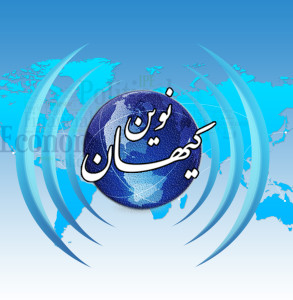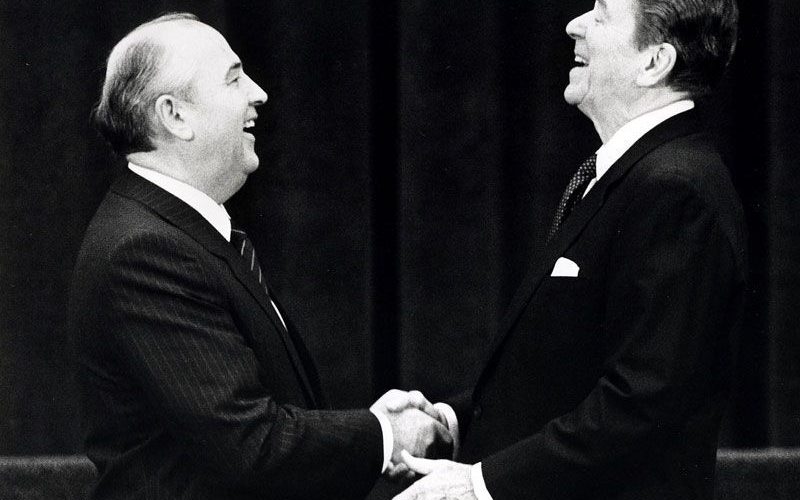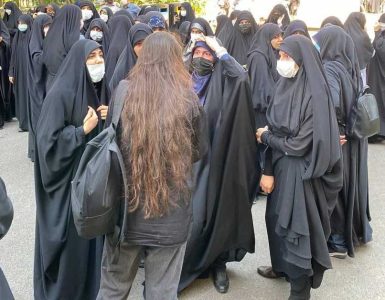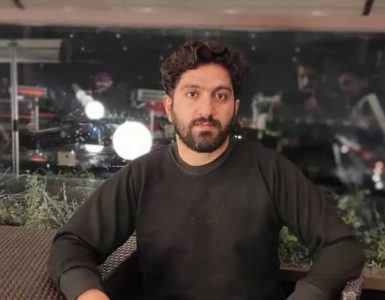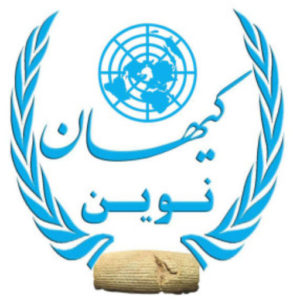به همان اندازه که سید علی خامنهای رهبر جمهوری اسلامی، برای عملی کردن آرزوهای ژئوپلیتیک خود برای ارتقاء جایگاه رژیم اسلامی و نقش منطقهای و بینالمللی آن به گزینه اتحاد با روسیه دل بسته است، به همان میزان از آلوده شدن رژیم خود به عفونتی که اتحاد جماهیر شوروی به آن مبتلا بود و در نهایت به سرنگونی رژیم کمونیستی منجر گردید، در ترس و تردید بسر میبرد.
As much as Seyyed Ali Khamenei, the leader of the Islamic Republic, is committed to the option of alliance with Russia in order to realize his geopolitical aspirations for the promotion of the position of the Islamic regime and its regional and international role, to the same extent that his regime is infected with the infection that the Soviet Union The Soviet Union was suffering from it and it finally led to the overthrow of the communist regime, it lives in fear and doubt.
کیهان نوین: این روزها ترس و نگرانی خامنهای بیشتر داخلی و از درون نظام است تا از «دشمن» خارجی!
میرحسین موسوی درواقع خواستار تغییر کلی نظام شد اما به زبانی دیگر و از طریق تغییر قانون اساسی. او بعد از اعتراضات سراسری اخیر و پافشاری مردم ایران برای احقاق حقوق ملی خود، گویا متوجه شده که یک تغییر اساسی و ریشهای در داخل ایران اتفاق افتاده و این تغییر از همه ثابتهایی که رژیم به آن پایبندی شدید دارد، فراتر رفته است.
خامنهای که هشت سال است در میان جناحهای متخاصم رژیم بر سر ارث و میراث خود بسر میبرد، میکوشد تا نقشهای برای دوران انتقالی رژیم ترسیم کند که تداوم ماهیت تئوکراتیک نظام را تضمین کند تا دومین و آخرین رهبر برای جمهوری اسلامی مانند میخائیل گورباچف که هفتمین و آخرین رهبر اتحاد جماهیر شوروی بود، نباشد.
خامنهای پرسترویکا را دلیل سرنگونی اتحاد جماهیر شوروی میداند، بنابراین او نسبت به یک گورباچف ایرانی که در حال ظهور یا طرفدار نسخه ایرانی پرسترویکا باشد، نگران و در ترس و تردید است.
خامنهای در سخنرانی اخیر خود در فرماندهی نیروی هوایی ارتش خواستار تمرکز بر وحدت ملی شد. او وحدت ملی را به عنوان نیاز اساسی و مهم برای نظام جمهوری اسلامی دانست و گفت: وحدت ملی نقش مهمی در پیروزی و پیشرفت انقلاب داشت و سد و دیواری در مقابل دشمنان ایجاد کرد.
رهبر جمهوری اسلامی به مقامات هشدار داد که «مبادا دشمنان (طبق توصیف خودش) باعث ایجاد اختلاف و شبهه بین آنها شوند».
از این رو میتوان گفت که ترس و نگرانی خامنهای بیشتر داخلی و از درون نظام است تا از «دشمن» خارجی.
خامنهای از کسانی که روزی بخشی از رهبران تاریخی انقلاب و نظام اسلامی بودند (محمد خاتمی و میرحسین موسوی) که اکنون به این نتیجه رسیدهاند که برای نجات نظام باید اقدامات جدی، اساسی و ریشهای رخ دهد تا نظام بازسازی شود، بیشتر واهمه دارد.
در همان زمان جنبش سبز سال ۲۰۰۹، رهبر جمهوری اسلامی ایران بیاعتمادی خود را به جنبش سیاسی میرحسین موسوی نشان داد. ترس خامنهای از میرحسین موسوی از آن جهت قابل توجیه است که موسوی از درون خود رژیم است اما اکنون ظاهرا در نقطه مقابل نظام قرار گرفته است.
خامنهای فکر میکند که میرحسین موسوی تنها مهرهای است که همچنان در نهادهای دولت، انقلاب و میان نخبگان داخلی رژیم هنوز دارای وزن سیاسی است و تجربه سابق او در مقام نخست وزیری فارغ از موقعیت، ماهیت اجتماعی و وضعیت سیاسی کنونی او، تهدیدی دائمی برای اوست. به این دلیل که موقعیت و سابقه موسوی به او توانایی میدهد تا خامنهای را به چالش بکشد به ویژه که هیچیک از چهرههای کنونی داخل رژیم اسلامی رقیبی جدی برای خامنهای به شمار نمیروند پس از نظر رهبر جمهوری اسلامی، میرحسین موسوی تنها کسی است که میتواند خلاء علی اکبر هاشمی رفسنجانی را که در برههای از عمر جمهوری اسلامی نقش طراح اصلی در مراکز تصمیمگیری داخلی رژیم را به عهده داشت، پر کند.
میرحسین موسوی در بیانیه اخیر خود که در آن خواستار تدوین قانون اساسی جدید برای ایران جهت نجات کشور شده بود، در حقیقت تمام نیروهای مخالف داخل رژیم و حامیان آن را دور زد و از خطوط قرمز رژیم و حتی دایره ملاحظات اصلاحطلبان درونی فراتر رفت. او درواقع خواستار تغییر کلی نظام شد اما به زبانی دیگر و از طریق تغییر قانون اساسی.
فراخوان میرحسین موسوی برای قانون اساسی جدید برای ایران و اعتراف او به اینکه درخواست ۱۳ سال پیش وی برای اجرای کامل قانون اساسی دیگر کافی نیست، به منزله طغیان و کودتایی علیه قانون اساسی و و ماهیت اعتقادی و اصل رژیم و تخطی از تمام خطوط قرمز یا سقفهایی که رژیم تئوکراتیک ولایت فقیه برای محافظت از خود در برابر هر خواستهای از قبیل اصلاحات یا تغییرات ناشی از تلاش نخبگان سیاسی یا نیروهای اجتماعی یا مردمی تعیین کرده بود، به شمار میرود.
میرحسین موسوی اینبار توانایی رژیم برای ادامه حیات به شکل کنونی خود را از رأس هرم یعنی خامنهای و بیت او تا پایینترین نهاد در کشور و همه باورهای ثابت و غیرقابل بحث رژیم را زیر سئوال برده است. او بعد از اعتراضات سراسری اخیر و پافشاری مردم ایران برای احقاق حقوق ملی خود، گویا متوجه شده که یک تغییر اساسی و ریشهای در داخل ایران اتفاق افتاده و این تغییر از همه ثابتهایی که رژیم به آن پایبندی شدید دارد، فراتر رفته است.
شنبه گذشته موسوی در بیانیهای به صراحت اعلام کرد: «ایرانیها آماده تحولی ریشهای هستند که خطوط اساسی آن را جنبشی ترسیم میکند که شعارش «زن، زندگی، آزادی»است.»
میرحسین موسوی پس از ۱۳ سال حصر خانگی به علت رهبری جنبش سبز در سال ۲۰۰۹، بار دیگر به صحنه برگشته تا با مطرح کردن چنین پیشنهادی بار دیگر باعث نگرانی و تردید و ترس خامنهای شود. او یکی از معماران رژیم اسلامی و دستگاه اجرایی آن در سختترین شرایط یعنی زمان جنگ با عراق بود. اما امروز شجاعانه صدای آشکار مردم ایران را شنیده و به ایرانیان میگوید که عمر این نظام احتمالاً به پایان خود نزدیک میشود.
بر این اساس، رژیم ایران که با رهبری خامنهای گزینههای خود را بسیار محدود کرده، برای اولین بار با معضلی روبرو شده است که این معضل رژیم را در میان دو گزینه تلخ قرار داده است:
یکی، اصلاحات کشنده مانند تجربه تلخ پرسترویکای اتحاد جماهیر شوری
دیگری، سرنگونی یا تغییر کلی رژیم همانطور که میرحسین موسوی از راه تغییر قانون اساسی خواستار پایان دادن به آن مانند پایان اتحاد جماهیر شوروی شده است.
*منبع: شرق الاوسط
New Universe:
These days, Khamenei’s fear and concern is more internal and from within the system than from the foreign “enemy”!
Mirhossein Mousavi actually called for a total change of the system, but in a different language and through changing the constitution. After the recent nationwide protests and the insistence of the Iranian people to assert their national rights, he seems to have realized that a fundamental and radical change has taken place inside Iran and that this change has gone beyond all the constants that the regime adheres to.
Khamenei, who has been among the regime’s warring factions over his legacy for eight years, is trying to draw a plan for the transition period of the regime that will ensure the continuation of the theocratic nature of the system, to the second and last leader for the Islamic Republic, like Mikhail Gorbachev, who is the seventh and He was the last leader of the Soviet Union.
Khamenei sees perestroika as the reason for the fall of the Soviet Union, so he is wary of an emerging Iranian Gorbachev or a proponent of the Iranian version of perestroika.
In his recent speech at the Air Force Command, Khamenei called for focus on national unity. He considered national unity as a fundamental and important need for the Islamic Republic system and said: National unity played an important role in the victory and progress of the revolution and created a barrier and a wall in front of the enemies.
The leader of the Islamic Republic warned the authorities that “lest the enemies (according to his description) cause differences and doubts between them”.
Therefore, it can be said that Khamenei’s fear and concern is more internal and from within the system than from the external “enemy”.
Khamenei is more afraid of those who were once part of the historical leaders of the revolution and the Islamic system (Mohammed Khatami and Mirhossein Mousavi) who have now come to the conclusion that to save the system, serious, fundamental and radical measures must be taken to restore the system.
At the same time as the Green Movement in 2009, the leader of the Islamic Republic of Iran showed his distrust in the political movement of Mirhossein Mousavi. Khamenei’s fear of Mirhossein Mousavi is justified because Mousavi is from within the regime, but now he is apparently at the opposite end of the regime.
Khamenei thinks that Mirhossein Mousavi is the only piece that still has political weight in the institutions of the government, the revolution and among the internal elites of the regime, and his former experience as a prime minister is a constant threat to him regardless of his position, social nature and current political situation. . Because Mousavi’s position and history gives him the ability to challenge Khamenei, especially since none of the current figures within the Islamic regime are serious rivals to Khamenei, then according to the leader of the Islamic Republic, Mirhossein Mousavi is the only one who can fill the vacuum. Ali Akbar Hashemi Rafsanjani, who at one point in the life of the Islamic Republic, was the main designer in the regime’s internal decision-making centers.
In his recent statement, in which he called for a new constitution for Iran to save the country, Mirhossein Mousavi, in fact, bypassed all the opposition forces within the regime and its supporters and went beyond the red lines of the regime and even the circle of considerations of internal reformers. He actually called for a total change of the system, but in a different language and through changing the constitution.
Mirhossein Mousavi’s call for a new constitution for Iran and his admission that his request 13 years ago for the full implementation of the constitution is no longer sufficient, constitutes an uprising and a coup against the constitution and the religious nature and principle of the regime and a violation of all red lines or The ceilings that the theocratic regime of Velayat al-Faqih had set to protect itself against any demands such as reforms or changes caused by the efforts of political elites or social or popular forces are considered.
This time, Mirhossein Mousavi has questioned the ability of the regime to continue its existence in its current form, from the top of the pyramid, namely Khamenei and his house, to the lowest institution in the country and all the fixed and indisputable beliefs of the regime. After the recent nationwide protests and the insistence of the Iranian people to assert their national rights, he seems to have realized that a fundamental and radical change has taken place inside Iran and that this change has gone beyond all the constants that the regime adheres to.
Last Saturday, Mousavi clearly stated in a statement: “Iranians are ready for a radical transformation, the basic lines of which will be drawn by a movement whose slogan is “woman, life, freedom”.
Mirhossein Mousavi, after 13 years of house arrest due to the leadership of the Green Movement in 2009, has returned to the stage once again to make Khamenei worry, doubt and fear by making such a proposal. He was one of the architects of the Islamic regime and its executive body in the most difficult conditions, i.e. during the war with Iraq. But today, he courageously listened to the clear voice of the Iranian people and told Iranians that the life of this system is probably nearing its end.
Based on this, the Iranian regime, which has limited its options under the leadership of Khamenei, has faced a dilemma for the first time, which has placed the regime between two bitter options:
One, fatal reforms such as the bitter experience of perestroika in the Soviet Union
The other is the overthrow or total change of the regime, as Mirhossein Mousavi has demanded by changing the constitution to end it like the end of the Soviet Union.
*Source: Sharq al-Awsat

